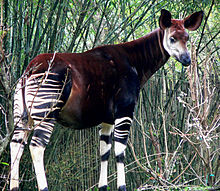Cryptid: Difference between revisions
Okiefromokla (talk | contribs) m Reverted edits by 72.18.96.211 to last version by 67.177.69.68 (HG) |
m removed template add from anon 2 edits ago |
||
| Line 38: | Line 38: | ||
{{Template:Cryptozoology}} |
{{Template:Cryptozoology}} |
||
{{teptlate:naruto}} |
|||
Revision as of 16:15, 22 July 2008

In the study of cryptozoology, a cryptid is any animal or creature whose existence has been reported but not proven scientifically. Their presumed existence is often derived from anecdotal evidence and/or other evidence insufficient to prove their existence according to normal scientific standards. The term was coined by John E. Wall in 1983.[1]
The term cryptid applies to presumed biological creatures such as the Yeti, Sasquatch, Champ, the Loch Ness Monster, and Mokele-mbembe. It is also applied by cryptozoologists to animals whose existence is accepted by the scientific community, but which are considered of interest to cryptozoology, such as the coelacanth and the okapi. These animals may have been once presumed extinct, and/or once thought to be a fictional animal, but are seen as "former cryptids," for they have now been scientifically verified. However, mythical creatures such as the griffin, the unicorn, the dragon, and the Kraken, which are now regarded as entirely fictious entities and/or exaggerated sightings of creatures unknown in earlier times, are often incorrectly described as "cryptids" by writers outside of cryptozoology, but cryptozoologists would never use the moniker "cryptid" with those examples. Source: Cryptozoology A to Z: The Encyclopedia of Loch Monsters, Sasquatch, Chupacabras, and Other Authentic Mysteries of Nature by Loren Coleman and Jerome Clark (NY: Simon and Schuster, 1999, ISBN 0-684-85602-6).
Cryptids may include animals which were known to man but have since become extinct, and which are claimed to be living today, such as the moa and thylacine.
Despite the large number of reported cryptids, most have not been proven, and many have been debunked through thorough scientific investigation by both cryptozoologists and zoologists.
Still, cryptozoology is a subject that has made its way into popular culture and often intrigues media consumers, as illustrated by websites like [http://www.cryptozoology.com and shows like MonsterQuest.
See also
- Cryptozoology
- List of cryptids
- List of legendary creatures
- List of U.S. paranormal guides
- Living dinosaurs
Footnotes
- ^ "John E. Wall of Manitoba coined it [the word "cryptid"] in a letter published in the summer 1983 issue of the ISC Newsletter (vol. 2, no. 2, p. 10), published by the International Society of Cryptozoology." Coleman, L. in Cryptomundo.com
References
- Coleman, Loren (1999). Cryptozoology A to Z: The Encyclopedia of Loch Monsters, Sasquatch, Chupacabras, and Other Authentic Mysteries of Nature. New York, New York: Simon and Schuster. ISBN 0-684-85602-6.
- Cohen, Daniel (1970). A Modern Look At Monsters. Cornwall, New York: The Cornwall Press, Inc. ISBN 0-396-06200-8.
- Cohen, Daniel (1989). Encyclopedia of Monsters: Bigfoot, Chinese Wildman, Nessie, Sea Ape, Werewolf and many more... London: Michael O'Mara Books Ltd. ISBN 0-948397-94-2.
- Mackal, Roy P. (1980). Searching For Hidden Animals: An Inquiry into Zoological Mysteries. USA: Self published. ISBN 0-385-14897-6.
